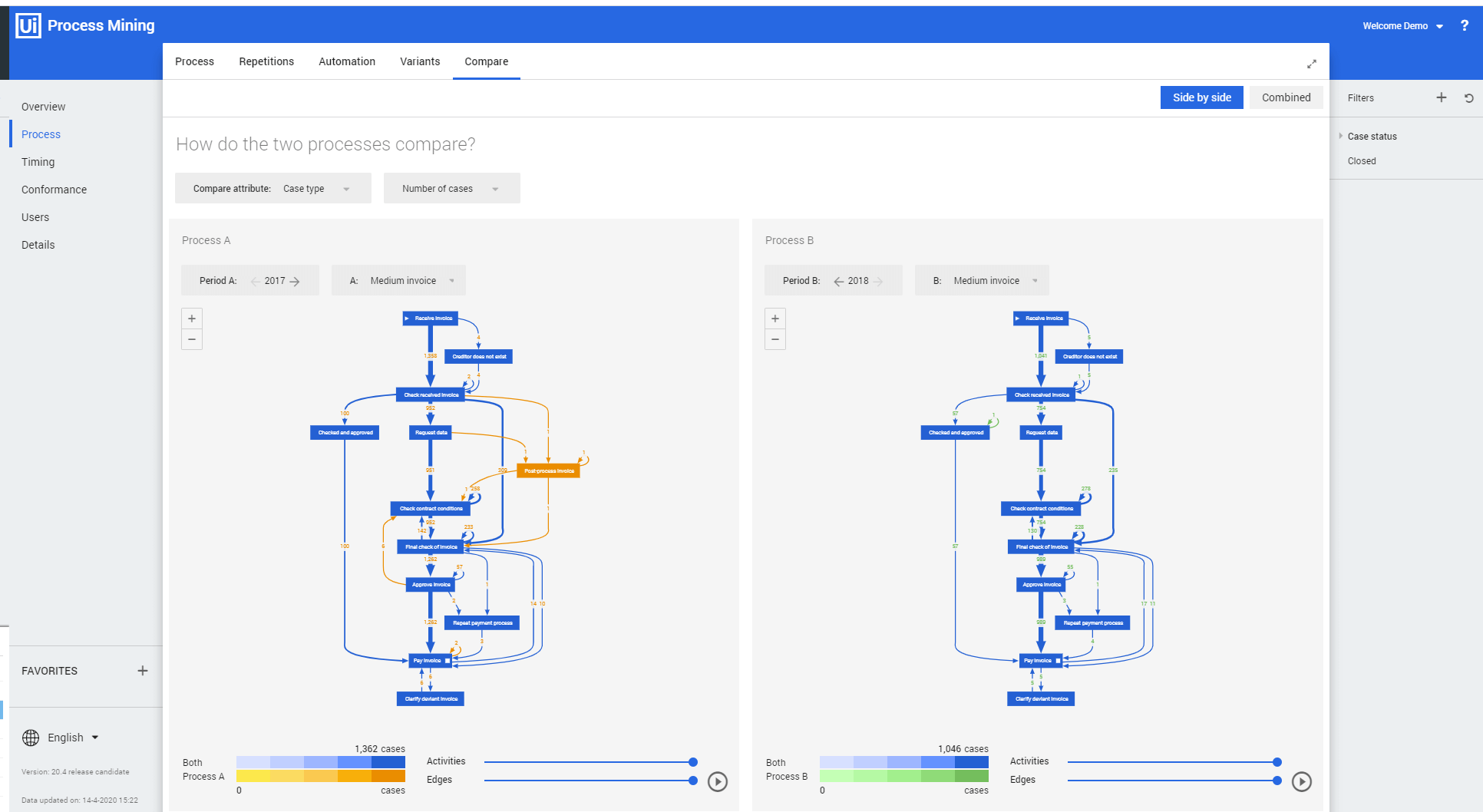How Enterprises Are Improving Operational Efficiency with Process Mining
Share at:

Pam Pijnenborg was previously a trainee consultant at UiPath.
Big data. The 'hype' around attractive projects with unimaginable amounts of data has calmed down since 2016. Businesses worldwide understood the value of stored information but were unclear how to investigate and act on it. Despite the current silence around big data, data analytics technologies are gaining momentum.
Today, organizations register greater amounts of data than ever before to analyze processes. Traditional business process management (BPM) and business intelligence (BI) techniques aren’t enough, as they don’t provide detailed insights on a process and its measurement.
Process mining, on the other hand, combines data mining and model-based process analysis. It drives the improvement of business performance factors like financial and operational efficiency.
To deliver an exceptional product or service while taking the leading position in the market, companies must prioritize business transformation. If you happen to be one of those companies and are looking into restructuring processes, your top-of-mind questions likely are:
What happens in a specific process?
What are the root causes of inefficiencies?
Are there deviations from the intended process and if so, what are they? What are the bottlenecks?
How much does an out-of-sync process cost me?
How can I optimize or automate the process? How much cash and time will I save?
All these questions can be answered by using UiPath Process Mining.
Why process mining?
As companies grow, they use business information systems across departments to collect, process, store, and distribute corporate information. Among those, you may find customer relationship management (CRM), accounting, enterprise resource planning (ERP), BPM, diverse databases, and other tools. The data with untapped potential often lays forgotten on the back end such as SAP, Oracle, Salesforce, even your Microsoft Excel sheets.
Think of what this data represents - exact information on who did what and when in the organization. Imagine how much golden knowledge is there.
With a process mining tool, you can use this data and gain insights to guide you in strategic decisions. Extracting the most relevant business information from event logs, and analyzing it further, you will understand what actions should follow to boost business performance.

Process mining vs. traditional process analysis
In traditional process discovery, companies turn to external business consultants. With their help, managers can take a deeper look at their processes via workshops and interviews.
Why doesn’t it always work?
Because traditional process discovery is time-consuming. Besides, it binds resources, since the interviewees cannot perform other work.
Such methods also provide an incomplete picture, can be very costly, and often come along with inherent subjectivity or bias. Whereas process mining does not have these drawbacks. It is time-efficient and frees up resources. Process mining provides objective results so you can see what happened in a process.
In short, it generates a complete picture that no other tool can give you. With process mining, there is no need for a team of expensive external consultants to discover the actual processes.
The control over your business is now in your hands.
Looking for signs of inefficiency
Process mining generates valuable insights that improve business processes. Intuitive and easy to use, process visualization greatly speeds up insight generation time. It lets you investigate what the process really is. It is a fast and easy technique to control and improve your operations.
Besides, such tools help to quickly detect a wide range of issues like supply chain delays and understaffing. Tackling the problem at an early stage empowers you to prevent some of the worst-case scenarios.
It’s important to remember that what's hidden from your eye are the process variations. Think of the human factor - skipping a step, taking another day to finish a task, or adding someone else into the workflow. From our experience, there are at least 10 scenarios of how your employees perform their job. Knowing all the variations allows you to find and align the best practices.
Analyze, adjust, and track results
When analyzing process mining outcomes, you come up with a plan of actions to increase operational efficiency. In turn, it's easy to track the effectiveness of the measures. In the final analysis, you can compare a process models’ variations and observe the impact of adjustments.
As a result, your business gains more financial savings by acting on truthful insights.
Continuous monitoring of processes
Again, process mining isn’t a one-time exercise. It’s designed for continuous optimization of processes. Therefore, you may also use it for automated process advice. In this case, a process mining platform automatically scans processes for improvement opportunities and makes proactive recommendations to end users.
It can even predict if a due date will be exceeded, using historical and current data. Not to mention predictions of the length of expected throughput time.
Management teams can make an accurate analysis of the core operations and detect root causes and bottlenecks. Process mining then addresses inefficiencies and non-compliance issues at their core. So, users can make informed decisions about areas for improvement to focus on.
As an enterprise, you can avoid unforeseeable issues and secure your position to meet or surpass customer expectations.
Practical advice: Using UiPath Process Mining tags for functional insights

While analyzing performance, remember your key performance indicators (KPIs) and use tags for them. The tagging feature (only available via UiPath) enriches your data set, adding business logic to it.
Let's say you want to discover the process KPIs that are relevant to the business. Whether business goals are set by your company or industry, the UiPath Process Mining tags function will allow you to measure your business goals. Get insights quicker by tracking any tag type you want such as inefficiency, rework, or violation.
An example of an inefficiency tag type could be that the contract conditions were not checked well. If many final checks of an invoice happened, it could be a rework tag type. A service level agreement (SLA) violation could be a violation tag type.
With UiPath Process Mining, you can identify these faster and easier, and prevent unwanted events. You may also add ranks of importance or influence among tags, to find cases that score high for specific tag types and pinpoint where to optimize them.
Process mining helps businesses highlight process deviations and recognize possibilities for improvement. You can identify any deviations like time, result, or order related. Hence, it uses the digital traces left behind by every digitally driven operation in a company.
With all these advantages, process mining is a must-have instrument for growth as the computation power increases and data storage continues to grow.
It’s obvious – the need for process mining techniques has truly arrived!
Want to learn more? Check out our on-demand webinar UiPath Process Mining: Scientifically Discover Your Next Automation Opportunity.

Data Scientist, ASML
Get articles from automation experts in your inbox
SubscribeGet articles from automation experts in your inbox
Sign up today and we'll email you the newest articles every week.
Thank you for subscribing!
Thank you for subscribing! Each week, we'll send the best automation blog posts straight to your inbox.



